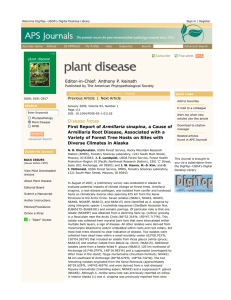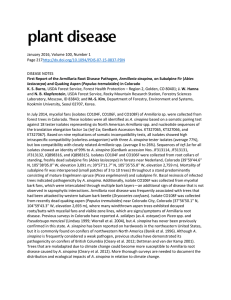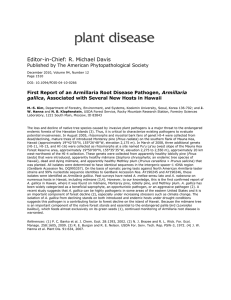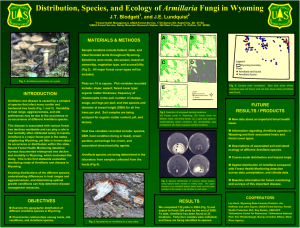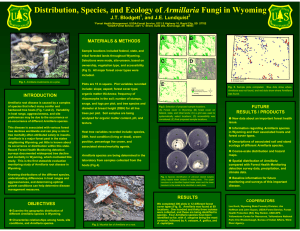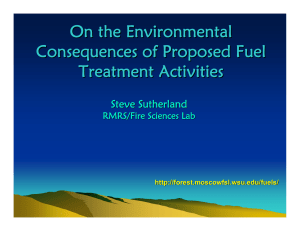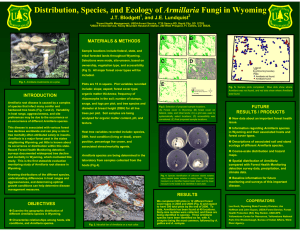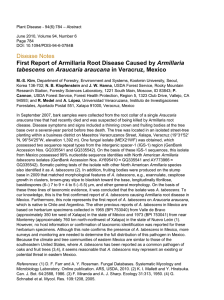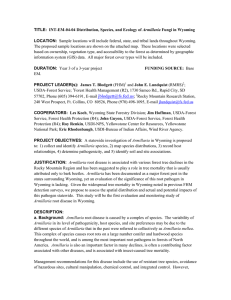Toward predicting climatic influences on distribution of Armillaria root-disease pathogens
advertisement
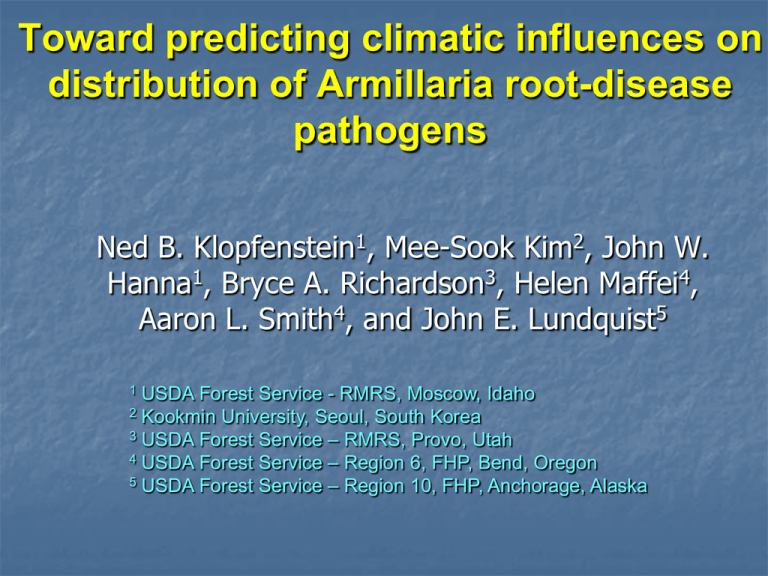
Toward predicting climatic influences on distribution of Armillaria root-disease pathogens Ned B. Klopfenstein1, Mee-Sook Kim2, John W. Hanna1, Bryce A. Richardson3, Helen Maffei4, Aaron L. Smith4, and John E. Lundquist5 1 USDA Forest Service - RMRS, Moscow, Idaho 2 Kookmin University, Seoul, South Korea 3 USDA Forest Service – RMRS, Provo, Utah 4 USDA Forest Service – Region 6, FHP, Bend, Oregon 5 USDA Forest Service – Region 10, FHP, Anchorage, Alaska Pervasive diseases, such as Armillaria root disease, are primary limiting factors for survival, growth, productivity, capacity to sequester carbon, and sustainability of forest trees Photo: RMRS Archives Photo: William Jacobi Photo: Manitoba Conservation Photo: John Hanna Impact of Armillaria root disease on tree growth Volume loss has been shown as high as 40% over 4-8 years in eighteen-year-old Douglas-fir. Cruickshank et al., 2000 Features of the genus Armillaria: - Diverse ecological roles (e.g., beneficial saprophyte or virulent pathogen) - Worldwide distribution, and wide host range - Diverse environmental requirements - Potential for long-term and wide-spread occupancy of a site - Comprised of several species Photo: Raini Rippy - Potential for gene flow within or among species Distribution of Armillaria solidipes (= A. ostoyae) ? ? ? ? ? ? ? ? ? ? ? ? Hanna 2005 Armillaria root disease is predicted to cause more problems under climate change, because stressed or maladapted trees are more susceptible to the Armillaria pathogen. Furthermore, aggressive Armillaria pathogens can cause severe disease in some tree species that are well-adapted to the site. In many regions, Armillaria root disease predisposes trees to bark beetle attack Photo: Fred Baker Predictions of climate-change influences on Armillaria root disease are needed so that appropriate management can be implemented to ameliorate negative impacts. Root diseases and climate change Climate change could alter patterns root disease through diverse mechanisms. • direct effects on the development, survival, reproduction, dispersal, and distribution of hosts and pathogens • physiological changes in tree defenses • indirect effects from changes in the abundance of mutualists and competitors Ayres and Lombardero, 2000 Baseline information is needed to predict potential impacts climate change on forest disease To obtain environmental data for these predictions, we must determine the current distribution of accurately identified pathogens and hosts determine climate and other environmental factors that are associated with pathogens, hosts, and disease development. Fao.org We should understand how the present climate influences the distribution of Armillaria spp. before we can predict the influences of future climate change Random survey plots are needed across a diverse environments and hosts. Even non-symptomatic trees should be inspected. The presence and absence of Armillaria sp. should be documented across many sites. Arm illaria collection plots Collaboration B.C. Ministry of Forests Previous Data G. I. McDonald Collaboration FHP Region 6 We must develop capacity to predict current distribution, before we can predict future distribution under climate change. Armillaria inspections and collections Random 0.04 ha Plots Plots and trees are mapped Trees are inspected Determine habitat types Collections are established in culture Armillaria species identification Climate data are available from several sources Example sources for climate data WorldClim http://www.worldclim.org/ Daymet http://www.daymet.org/ Rehfeldt et al. (2006) http://forest.moscowfsl.wsu.edu/climate/inde x.html Rehfeldt et al. 2004 Current Mean Annual Precipitation for western North America Approach to predict suitable climate space for Armillaria solidipes • Collection sites • 202 with known presence of Armillaria solidipes • Species confirmed by DNA sequencing • Climate data – Rehfeldt et al. (2006) • http://forest.moscowfsl.wsu.edu/climate/index. html • A set of western NA climate layers (climate grids) with a spatial resolution of a square kilometer • 35 climatic variables and interactions including monthly total precipitation, and monthly mean, minimum and maximum temperature. Current suitable climate space for Armillaria solidipes: Inland northwestern U.S.A. Current (preliminary) Dark Green = Low suitability; Light Green = Medium suitability; Yellow = High suitability; Orange = Very high suitability; Red = Excellent suitability (MAXENT model of suitable climate space) Predicting bioclimate profile – Douglas-fir (Pseudotsuga menziesii) Rehfeldt et al. 2006 Current suitable climate space for Armillaria solidipes and Douglas-fir Armillaria solidipes (preliminary) Douglas-fir (Rehfeldt et al. 2006) Dark Green = Low suitability; Light Green = Medium suitability; Yellow = High suitability; Orange = Very high suitability; Red = Excellent suitability (MAXENT model of current suitable climate space) Future climate data General Circulation Models (GCMs) Examples: 1) CGCM3 – Canadian Centre for Climate Modelling and Analysis 2) HadCM3 – Hadley Center 3) GFDL CM2.1 – Geophysical Fluid Dynamics Laboratory These different GCMs can incorporate to various greenhouse gas scenarios. For the Armillaria ostoyae examples, we used the A1B scenario which models a conservative increase in CO2 emissions Prediction Models Sott.net MAXENT (Armillaria ostoyae) and Random Forest (Douglas-fir) Current and future climate Current Climate Year 2090 Change in Degree Days > 5C from Current to 2090 using the CGCM3 model and a greenhouse gas scenario provided by The Intergovermental Panel on Climate Change (IPCC) Rehfeldt et al. 2006 Future suitable climate space for Armillaria solidipes: inland northwestern North America Year 2060 (preliminary) Dark Green = Low suitability; Light Green = Medium suitability; Yellow = High suitability; Orange = Very high suitability; Red = Excellent suitability (MAXENT model of future suitable climate space) Current and future suitable climate space for Armillaria solidipes Current (preliminary) Year 2060 (preliminary) Dark Green = Low suitability; Light Green = Medium suitability; Yellow = High suitability Orange = Very high suitability; Red = Excellent suitability (MAXENT model of current and future suitable climate space) Prediction of suitable climate space for Douglas-fir Current Year 2060 Red = Suitable predicted climate >75% of Random Forest decision tree votes Yellow = Marginal predicted climate 50-75% of Random Forest decision tree votes Grey = Climate not suitable for Pseudotsuga menziesii Suitable climate space for Pseudotsuga menziesii is predicted to decline by 46% in the western US through 2060. Rehfeldt et al. 2006 Current suitable climate space for Armillaria solidipes and Douglas-fir Armillaria solidipes (preliminary) Douglas-fir (Rehfeldt et al. 2006) Predicted future suitable climate space for Armillaria solidipes and Douglas-fir Armillaria solidipes Year 2060 (preliminary) Douglas-fir Year 2060 Rehfeldt et al. 2006) Dark Green = Low suitability; Light Green = Medium suitability; Yellow = High suitability; Orange = Very high suitability; Red = Excellent suitability (MAXENT model of current suitable climate space) Are we headed for a disaster?? Without appropriate management, we may be headed for a disaster. Photo: B.C. Ministry of Forests and Range Predictions of climate-change influences on Armillaria root disease can guide management for reducing negative impacts Detailed biological information is needed to improve bioclimatic modeling of forest diseases To improve predictive modeling, we need to understand 1) the population structure and distribution of the hosts and pathogens in relation to environmental factors; 2) abiotic components of the ecosystem, such as soil properties; 3) biotic components of the ecosystem, such as biological control agents; 4) adaptive capacity of biotic components via hybridization, natural selection, and phenotypic plasticicty; and 5) ability of biological components to migrate to suitable climate space. USDA - ARS Summary points We cannot predict future climatic influences on forest pests if we cannot predict the present or past climatic influences on forest pests Large data sets are needed to develop and validate any predictive model for forest Examples of useful data Precise geographic location, including slope and aspect, with presence/absence information DNA-based identification of species (or population) Associated environmental information (e.g. soils, habitat type, stand information, etc.) New Publication To obtain a pdf of this publication: http://www.fs.fed.us/rm/publications Printed copies are also available from RMRS publications Collaborators FHP Region 6 – Helen Maffei, Aaron Smith FHP Region 10 – John Lundquist FHP Region 3 – Mary Lou Fairweather B.C. Ministry of Forests and Range – Michelle Cleary Photo: William Jacobi Canadian Forest Service – Mike Cruickshank, Rona Sturrock And several others … Additional collaborations are encouraged!
